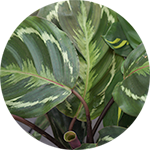
Get to Know Houseplants

Foliage
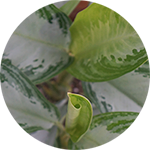
Chinese Evergreen,
Aglaonema varieties
Aglaonema varieties
Light
Low, medium and high. While all plants appreciate high levels of light, some tolerate low light. Green leaf varieties do well in low light, and the colorful leaf types require more light to keep the foliage bright.
Water
Low and medium. Green/silver leaf types prefer drier soil; colorful varieties need slightly more moisture. Plants will use water less efficiently in less light, check moisture level before watering.
Care
Minimal care: they tolerate a wide range of humidity, soils types. Fertilize once a month for faster growth. Re-pot if they dry out too fast or are too large for the container. Remove older leaves as they fade.
Traits
Toxic to pets, great for office environments.
Low, medium and high. While all plants appreciate high levels of light, some tolerate low light. Green leaf varieties do well in low light, and the colorful leaf types require more light to keep the foliage bright.
Water
Low and medium. Green/silver leaf types prefer drier soil; colorful varieties need slightly more moisture. Plants will use water less efficiently in less light, check moisture level before watering.
Care
Minimal care: they tolerate a wide range of humidity, soils types. Fertilize once a month for faster growth. Re-pot if they dry out too fast or are too large for the container. Remove older leaves as they fade.
Traits
Toxic to pets, great for office environments.
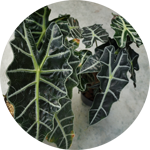
Elephant Ear, African Mask, Kris Plant
Alocasia spp.
Alocasia spp.
Light
Bright to moderate light. Direct sun, even cooler early morning sun, can result in smaller leaves. A little less light and the plant grows a bigger leaf to catch more light.
Water
Most Alocasia use water very efficiently and are best kept slightly moist. If kept too wet though they will rot. Check the soil once or twice a week to establish how fast it’s using water.
Care
Use a balanced fertilizer such as Bonide 10-10-10 once a month. Use potting soil when re-potting. Alocasia leaves tear and scar easily, place in a location where your plant can have space.
Traits
Not all Alocasia are large and not all have large leaves. A. ‘Polly’ grows approximately two feet and A. ‘Fairy’ looks like ‘Polly’ but with almost dainty leaves. Plants can go dormant, or partially dormant, during winter months, even inside. Cooler temperatures and shorter days will trigger the plant to reduce foliage.
Bright to moderate light. Direct sun, even cooler early morning sun, can result in smaller leaves. A little less light and the plant grows a bigger leaf to catch more light.
Water
Most Alocasia use water very efficiently and are best kept slightly moist. If kept too wet though they will rot. Check the soil once or twice a week to establish how fast it’s using water.
Care
Use a balanced fertilizer such as Bonide 10-10-10 once a month. Use potting soil when re-potting. Alocasia leaves tear and scar easily, place in a location where your plant can have space.
Traits
Not all Alocasia are large and not all have large leaves. A. ‘Polly’ grows approximately two feet and A. ‘Fairy’ looks like ‘Polly’ but with almost dainty leaves. Plants can go dormant, or partially dormant, during winter months, even inside. Cooler temperatures and shorter days will trigger the plant to reduce foliage.
Peacock Plant, Calathea varieties
Light
High, medium. Calathea will turn towards the light if it is coming from one direction, rotate plants for even growth.
Water
High, medium. Keep barely moist (like a well wrung-out sponge). Larger leaf types will not recover well from getting too dry, smaller leaf types are more flexible.
Care
Moderate to high humidity helps to keep them moist. Use a rich potting soil such as African Violet Mix when re-potting. Fertilize once a month for bushier plants.
Traits
Safe for pets.
High, medium. Calathea will turn towards the light if it is coming from one direction, rotate plants for even growth.
Water
High, medium. Keep barely moist (like a well wrung-out sponge). Larger leaf types will not recover well from getting too dry, smaller leaf types are more flexible.
Care
Moderate to high humidity helps to keep them moist. Use a rich potting soil such as African Violet Mix when re-potting. Fertilize once a month for bushier plants.
Traits
Safe for pets.
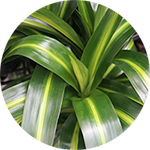
Dracaena varieties
Light
Low, medium and high. All plants appreciate bright, indirect light, and some Dracaena varieties do well in low to moderate light. Those with bright yellow, white stripes or wide leaves require high light to keep coloration. Narrow leaf types, with darker leaves tolerate low to moderate light.
Water
Low water use. Allow to dry out completely; they do not like to sit in water longer than an hour or two after watering. Plants use water less efficiently in less light.
Care
Low to moderate humidity. Use Cactus Potting Mix when repotting to avoid roots staying too wet. Fertilize once a month. Remove older foliage, and those leaf tips can be trimmed.
Traits
Air purifying. Brown leaf tips are a symptom of the plant staying too wet for too long. Dracaena marginata is also known as “Dragon Tree”.
Low, medium and high. All plants appreciate bright, indirect light, and some Dracaena varieties do well in low to moderate light. Those with bright yellow, white stripes or wide leaves require high light to keep coloration. Narrow leaf types, with darker leaves tolerate low to moderate light.
Water
Low water use. Allow to dry out completely; they do not like to sit in water longer than an hour or two after watering. Plants use water less efficiently in less light.
Care
Low to moderate humidity. Use Cactus Potting Mix when repotting to avoid roots staying too wet. Fertilize once a month. Remove older foliage, and those leaf tips can be trimmed.
Traits
Air purifying. Brown leaf tips are a symptom of the plant staying too wet for too long. Dracaena marginata is also known as “Dragon Tree”.
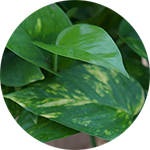
Pothos, Epipremnum varieties
Light
Low, medium and high. While all plants appreciate high light some tolerate low light. Pothos is one of the top low-light tolerant plants. Coloration on varieties such as ‘Neon’ and ‘Marble Queen’ fade over time in low light conditions
Water
Low and medium. Allow to dry evenly before watering. Water less often in low light conditions.
Care
Fertilize monthly for best foliage. Prune some of the stems as the plant ages to keep it from being stringy.
Traits
Air purifying, and easy to grow.
Low, medium and high. While all plants appreciate high light some tolerate low light. Pothos is one of the top low-light tolerant plants. Coloration on varieties such as ‘Neon’ and ‘Marble Queen’ fade over time in low light conditions
Water
Low and medium. Allow to dry evenly before watering. Water less often in low light conditions.
Care
Fertilize monthly for best foliage. Prune some of the stems as the plant ages to keep it from being stringy.
Traits
Air purifying, and easy to grow.
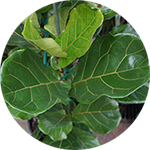
Fiddle Leaf Fig, Weeping Fig, Rubber Plant, Ficus varieties
Light
High. All tropical Ficus require bright indirect light and tolerate direct cool light such as sun though the window in early morning or late evening.
Water
Medium. Tropical figs do not like consistently wet soil, leaf spotting and leaf drop are symptoms of plants staying too wet. Allowing figs to get too dry results in foliage damage.
Care
Figs are best and bushiest in moderate to high humidity. Use Potting Soil when re-potting. Fertilize monthly for best growth. Easy to prune for size control.
Traits
Fiddle Leaf – Ficus lyrata; Weeping Fig –Ficus benjamina; Rubber Plant –Ficus elastica. We carry other species and multiple varieties of tropical figs when they’re available.
High. All tropical Ficus require bright indirect light and tolerate direct cool light such as sun though the window in early morning or late evening.
Water
Medium. Tropical figs do not like consistently wet soil, leaf spotting and leaf drop are symptoms of plants staying too wet. Allowing figs to get too dry results in foliage damage.
Care
Figs are best and bushiest in moderate to high humidity. Use Potting Soil when re-potting. Fertilize monthly for best growth. Easy to prune for size control.
Traits
Fiddle Leaf – Ficus lyrata; Weeping Fig –Ficus benjamina; Rubber Plant –Ficus elastica. We carry other species and multiple varieties of tropical figs when they’re available.
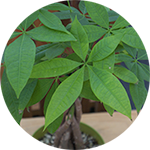
Money Plant, Pachyra aquatica
Light
Medium and high. Money plant grows best with bright, indirect light and tolerate direct cool light such as sun though the window in early morning or late evening. Plants turn towards the light, rotate plants for even growth.
Water
Low and medium. Allow plants to dry completely before watering, then water thoroughly. Avoid watering the stem.
Care
Moderate to high humidity is best for Money Plants. Fertilize monthly for the greenest foliage.
Traits
Yellowing leaves are a symptom of the plant staying too moist, for too long. Place where they are protected from bruising. The leaves are delicate and easily torn. Money Trees like to remain “cozy” in their pot, do not repot in a substantially larger container.
Medium and high. Money plant grows best with bright, indirect light and tolerate direct cool light such as sun though the window in early morning or late evening. Plants turn towards the light, rotate plants for even growth.
Water
Low and medium. Allow plants to dry completely before watering, then water thoroughly. Avoid watering the stem.
Care
Moderate to high humidity is best for Money Plants. Fertilize monthly for the greenest foliage.
Traits
Yellowing leaves are a symptom of the plant staying too moist, for too long. Place where they are protected from bruising. The leaves are delicate and easily torn. Money Trees like to remain “cozy” in their pot, do not repot in a substantially larger container.
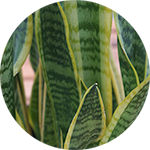
Snake Plant, Sansevieria varieties
Light
Low, medium and high. Snake plants are very flexible when it comes to light conditions.
Water
Low. Allow plants to dry out completely before watering. Water sparingly and less often in lower light conditions.
Care
Use Cactus Potting Mix when re-potting, and allow plants to ‘crowd’ the pot before transplanting. Fertilize once a month for faster growth.
Traits
Air purifying. There are many varieties of Sansevieria with different leaf shapes and variations of green, stripes and cream or yellow variegation. One of the easiest houseplants to keep happy.
Low, medium and high. Snake plants are very flexible when it comes to light conditions.
Water
Low. Allow plants to dry out completely before watering. Water sparingly and less often in lower light conditions.
Care
Use Cactus Potting Mix when re-potting, and allow plants to ‘crowd’ the pot before transplanting. Fertilize once a month for faster growth.
Traits
Air purifying. There are many varieties of Sansevieria with different leaf shapes and variations of green, stripes and cream or yellow variegation. One of the easiest houseplants to keep happy.
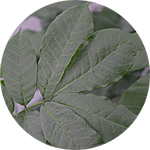
Natal Mahogany, Trichilia emitica
Light
Low, medium and high. Natal Mahogany tolerates low light.
Water
High. Natal Mahogany prefer soil to be consistently moist. They’ll be okay if allowed to sit in very shallow water when the air is dry and warm.
Care
High humidity keeps this plant bushier. Use Potting Soil when re-potting. Fertilize once a month or less often if plant grows too fast. Prune for size control.
Traits
The earliest new growth on this plant is slightly fuzzy and brown, avoid removing new growth from tips. Very easy to keep happy.
Low, medium and high. Natal Mahogany tolerates low light.
Water
High. Natal Mahogany prefer soil to be consistently moist. They’ll be okay if allowed to sit in very shallow water when the air is dry and warm.
Care
High humidity keeps this plant bushier. Use Potting Soil when re-potting. Fertilize once a month or less often if plant grows too fast. Prune for size control.
Traits
The earliest new growth on this plant is slightly fuzzy and brown, avoid removing new growth from tips. Very easy to keep happy.
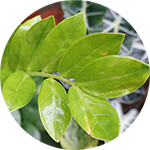
ZZ Plant, Zamioculcas zamiifolia
Light
Medium to high. Keep these succulent-type plants where they have enough light to use water efficiently.
Water
Low. Avoid allowing them to stay wet for long periods of time.
Care
Use Cactus Potting Mix when re-potting, and allow the plants to ‘crowd’ the pot before transplanting. Fertilize sparingly to avoid top-heavy growth.
Traits
Easy to grow. Can reach a height of 6’.
Medium to high. Keep these succulent-type plants where they have enough light to use water efficiently.
Water
Low. Avoid allowing them to stay wet for long periods of time.
Care
Use Cactus Potting Mix when re-potting, and allow the plants to ‘crowd’ the pot before transplanting. Fertilize sparingly to avoid top-heavy growth.
Traits
Easy to grow. Can reach a height of 6’.
Bromeliads
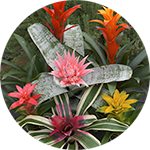
Aechmea fasciata ‘Morgana’, Guzmania, Neorgelia & Vriesea splenreit
Light
Medium and high. These plants grow in tropical and sub-tropical areas around the world. They rely on leaf cover to protect from strong, direct light.
Water
High. While soggy conditions cause rot, these plants are happier with water kept in the cups of their leaves.
Care
High humidity keeps bromeliads from getting too dry and preserves the flowers (colorful bracts). These varieties of bromeliads thrive in a loose soil such as Cactus potting mix. Use a very mild solution of fertilizer, if any.
Traits
The colorful blooms of bromeliad will last weeks, even months. Once the flower fades, the mother plant will eventually decline, leaving side growth (pup) to emerge, taking the place of the mother plant.
Medium and high. These plants grow in tropical and sub-tropical areas around the world. They rely on leaf cover to protect from strong, direct light.
Water
High. While soggy conditions cause rot, these plants are happier with water kept in the cups of their leaves.
Care
High humidity keeps bromeliads from getting too dry and preserves the flowers (colorful bracts). These varieties of bromeliads thrive in a loose soil such as Cactus potting mix. Use a very mild solution of fertilizer, if any.
Traits
The colorful blooms of bromeliad will last weeks, even months. Once the flower fades, the mother plant will eventually decline, leaving side growth (pup) to emerge, taking the place of the mother plant.
Flowering
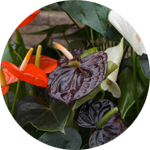
Flamingo Lily , Anthurium andraeanum
Light
Bright light is required to keep Anthuriums flowering. Anthurium will tolerate moderate light conditions and continue to grow big shiny leaves but will produce very few flowers, if any.
Water
These plants grow in rocky (lava) soil in very humid conditions. Allow roots to dry a bit before watering.
Care
Fertilize with an Orchid bloom or African Violet food to promote blooming. If your plant stops growing new leaves, switch to an Orchid grow fertilizer.
When repotting use a loose, well-draining soil mix such as Bonsai or Orchid mix.
Traits
The large heart shaped blooms on these plants can last weeks when left on the plant or as a cut flowers. While red is the most popular color they also bloom white, orange, pink, burgundy, purple, lavender and varying shades of these colors.
The genus Anthurium is a large group of plants, most of which are grown for the foliage. Anthurium andreanum species, with the spectacular flowers, is native to Colombia and Ecuador.
Bright light is required to keep Anthuriums flowering. Anthurium will tolerate moderate light conditions and continue to grow big shiny leaves but will produce very few flowers, if any.
Water
These plants grow in rocky (lava) soil in very humid conditions. Allow roots to dry a bit before watering.
Care
Fertilize with an Orchid bloom or African Violet food to promote blooming. If your plant stops growing new leaves, switch to an Orchid grow fertilizer.
When repotting use a loose, well-draining soil mix such as Bonsai or Orchid mix.
Traits
The large heart shaped blooms on these plants can last weeks when left on the plant or as a cut flowers. While red is the most popular color they also bloom white, orange, pink, burgundy, purple, lavender and varying shades of these colors.
The genus Anthurium is a large group of plants, most of which are grown for the foliage. Anthurium andreanum species, with the spectacular flowers, is native to Colombia and Ecuador.
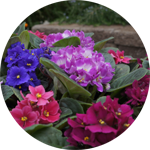
African Violet, Saintpaulia ionantha
Light
Bright, indirect light or early morning sun is required for blooming.
Water
The soil for African Violets is usually kept barely moist, like a well wrung-out sponge. Sometimes allowing the soil to become slightly dry will encourage better flowering. Watering from the base of the plant is recommended, to avoid getting water on the fuzzy foliage.
Care
Use fertilizer that is specifically for African Violets for the best growth and flowering. Use African Violet soil mix when re-potting.
Traits
In addition to a variety of flower colors and combinations these plants can also have varying leaf shades, variegations and textures. The foliage is fuzzy and is therefore susceptible to damage if water is allowed to remain on the leaves. There are pots specifically designed for African Violets to avoid water damage to the leaves. Older plants will push out baby plants on a stem that can be cut from the mother and potted.
Bright, indirect light or early morning sun is required for blooming.
Water
The soil for African Violets is usually kept barely moist, like a well wrung-out sponge. Sometimes allowing the soil to become slightly dry will encourage better flowering. Watering from the base of the plant is recommended, to avoid getting water on the fuzzy foliage.
Care
Use fertilizer that is specifically for African Violets for the best growth and flowering. Use African Violet soil mix when re-potting.
Traits
In addition to a variety of flower colors and combinations these plants can also have varying leaf shades, variegations and textures. The foliage is fuzzy and is therefore susceptible to damage if water is allowed to remain on the leaves. There are pots specifically designed for African Violets to avoid water damage to the leaves. Older plants will push out baby plants on a stem that can be cut from the mother and potted.
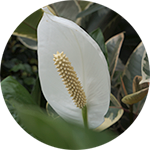
Peace Lily, Spathiphyllum wallisii
Light
Medium and high. Peace Lily blooms best with bright, indirect light.
Water
High. Keep slightly moist. Large, thin leaves and the ability to flower continually, is the result of these plants using water very efficiently. Peace Lily are forgiving if allowed to wilt, they re-hydrate with little foliage damage. But repeated wilting will show damage and inhibit blossoming.
Care
High humidity helps to keep these plants hydrated. Fertilize once month for best foliage and consistent flowering. Use a fertilizer with even numbers on the label such as 10-10-10.
Traits
Air purifying, and easy to grow.
Medium and high. Peace Lily blooms best with bright, indirect light.
Water
High. Keep slightly moist. Large, thin leaves and the ability to flower continually, is the result of these plants using water very efficiently. Peace Lily are forgiving if allowed to wilt, they re-hydrate with little foliage damage. But repeated wilting will show damage and inhibit blossoming.
Care
High humidity helps to keep these plants hydrated. Fertilize once month for best foliage and consistent flowering. Use a fertilizer with even numbers on the label such as 10-10-10.
Traits
Air purifying, and easy to grow.
Orchids
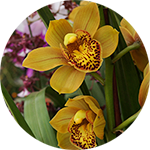
Corsage Orchid, Cymbidium
Light
High. Bright light is necessary for Cymbidium. Typically, they are grown on a protected patio, where the outside light is best. They’ll tolerate some direct sun, briefly, such as very early morning.
Water
Medium. These orchids need excellent drainage and don’t like wet roots.
Care
Very flexible plants, but they appreciate some humidity. Cymbidiums are terrestrial orchids, meaning they grow in soil. Use Orchid Potting Mix with a little fine Orchid Bark when re-potting. Fertilize when out of bloom.
Traits
Provide plants with crowded conditions; they won’t bloom when planted in roomy containers. Grow them outside in semi-shade. Temperatures need to be between 50-60°F to force flower spikes. Optimum temperatures in winter are 45-55°F at night and 55-75°F during the day. Move to more protection if temperatures drop lower than 40°F. Summer temperatures can be higher.
High. Bright light is necessary for Cymbidium. Typically, they are grown on a protected patio, where the outside light is best. They’ll tolerate some direct sun, briefly, such as very early morning.
Water
Medium. These orchids need excellent drainage and don’t like wet roots.
Care
Very flexible plants, but they appreciate some humidity. Cymbidiums are terrestrial orchids, meaning they grow in soil. Use Orchid Potting Mix with a little fine Orchid Bark when re-potting. Fertilize when out of bloom.
Traits
Provide plants with crowded conditions; they won’t bloom when planted in roomy containers. Grow them outside in semi-shade. Temperatures need to be between 50-60°F to force flower spikes. Optimum temperatures in winter are 45-55°F at night and 55-75°F during the day. Move to more protection if temperatures drop lower than 40°F. Summer temperatures can be higher.
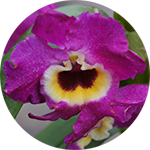
Spray Orchid, Dendrobium
Light
High. Bright light is always best for orchids when encouraging growth and bloom. Moving them to less bright location when in bloom will extend the bloom time.
Water
Medium. These orchids grow in trees and their roots don’t like constant moisture. But, they won’t thrive if kept too dry.
Care
Orchids are happiest in humid conditions, with moderate temperatures. Use Orchid Bark when re-potting with Dendrobiums a little Orchid Potting Mix with the bark can help if plants are in a drier location. Fertilize with a balanced orchid fertilizer. “Weakly, weekly” is the usual rule for fertilizing.
Traits
Only re-pot when plants are over grown and out of bloom; orchids perform best when crowded in their containers. Moderate temperatures are best for re-bloom.
High. Bright light is always best for orchids when encouraging growth and bloom. Moving them to less bright location when in bloom will extend the bloom time.
Water
Medium. These orchids grow in trees and their roots don’t like constant moisture. But, they won’t thrive if kept too dry.
Care
Orchids are happiest in humid conditions, with moderate temperatures. Use Orchid Bark when re-potting with Dendrobiums a little Orchid Potting Mix with the bark can help if plants are in a drier location. Fertilize with a balanced orchid fertilizer. “Weakly, weekly” is the usual rule for fertilizing.
Traits
Only re-pot when plants are over grown and out of bloom; orchids perform best when crowded in their containers. Moderate temperatures are best for re-bloom.
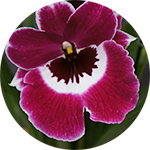
Pansy Orchid, Miltonia
Light
Medium and high. When encouraging orchids to set bloom bright, indirect light is necessary. Miltonia leaves will burn in direct sun. When in bloom, move to a less bright location to extend bloom time.
Water
Medium. These orchids grow in higher elevations in South America where it’s moist but not wet. Allow them to get almost completely dry before watering.
Care
High humidity helps this type of orchid stay hydrated. A mix of Orchid Bark and Orchid Potting Mix provides roots with the perfect drainage.
Traits
Miltonia bloom and thrive with cooler temperatures: between 80 and 50°F.
Medium and high. When encouraging orchids to set bloom bright, indirect light is necessary. Miltonia leaves will burn in direct sun. When in bloom, move to a less bright location to extend bloom time.
Water
Medium. These orchids grow in higher elevations in South America where it’s moist but not wet. Allow them to get almost completely dry before watering.
Care
High humidity helps this type of orchid stay hydrated. A mix of Orchid Bark and Orchid Potting Mix provides roots with the perfect drainage.
Traits
Miltonia bloom and thrive with cooler temperatures: between 80 and 50°F.
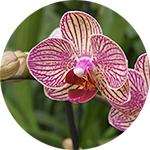
Moth Orchid, Phalaenopsis
Light
Medium and high. When encouraging orchids to set bloom, bright light is necessary. When in bloom, they can be moved to a less bright location to extend bloom time.
Water
Medium. Moth Orchids grow in trees and their roots don’t like constant moisture. But, they won’t thrive if kept too dry. If your plant has air roots they will be silvery-greenish and full when plant is hydrated. When dry, the air roots are all silver-grey.
Care
Orchids are happiest in humid conditions, with moderate temperatures. Use Orchid Bark when re-potting. Moss can be used if conditions are too dry, to retain moisture. Fertilize with an orchid growth formula when plants are out of bloom or during spring and summer. Use an orchid bloom formula fall and winter. “Weakly, weekly” is the usual rule for fertilizing.
Traits
Only re-pot when plants are over grown and out of bloom; orchids perform best when crowded in their containers. Bloom time is usually late fall, winter, early spring with temperatures a cooler.
Medium and high. When encouraging orchids to set bloom, bright light is necessary. When in bloom, they can be moved to a less bright location to extend bloom time.
Water
Medium. Moth Orchids grow in trees and their roots don’t like constant moisture. But, they won’t thrive if kept too dry. If your plant has air roots they will be silvery-greenish and full when plant is hydrated. When dry, the air roots are all silver-grey.
Care
Orchids are happiest in humid conditions, with moderate temperatures. Use Orchid Bark when re-potting. Moss can be used if conditions are too dry, to retain moisture. Fertilize with an orchid growth formula when plants are out of bloom or during spring and summer. Use an orchid bloom formula fall and winter. “Weakly, weekly” is the usual rule for fertilizing.
Traits
Only re-pot when plants are over grown and out of bloom; orchids perform best when crowded in their containers. Bloom time is usually late fall, winter, early spring with temperatures a cooler.
Palms
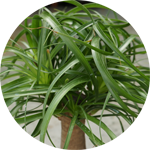
Ponytail Palm, Bottle Palm
Beaucarnea recurvata
Beaucarnea recurvata
Light
Bright to moderate light. If light is from one direction, rotate this plant before it leans towards the light to keep the trunk growing straight.
Water
Let Ponytail Palm dry completely between before watering. Water thoroughly when dry to achieve a large bulb. These plants hold a lot of water in their bodies, how slow or fast they use water and become sufficiently dry is important. Too wet too long and they can rot.
Care
Remove older leaves as they turn yellow or brown. Lower leaves can be gently peeled off to expose more of the trunk. Use a palm fertilizer for best results. If this plant is pushed to grow fast it may not form the characteristic large trunk.
Traits
As Beaucarnea age, the ribbon-like leaves can grow very long and twist. Often the tips turn brown on older foliage which is normal. If younger foliage tips start browning the plant is staying moist for too long. Cactus or Bonsai soil mixes are best when transplanting.
Bright to moderate light. If light is from one direction, rotate this plant before it leans towards the light to keep the trunk growing straight.
Water
Let Ponytail Palm dry completely between before watering. Water thoroughly when dry to achieve a large bulb. These plants hold a lot of water in their bodies, how slow or fast they use water and become sufficiently dry is important. Too wet too long and they can rot.
Care
Remove older leaves as they turn yellow or brown. Lower leaves can be gently peeled off to expose more of the trunk. Use a palm fertilizer for best results. If this plant is pushed to grow fast it may not form the characteristic large trunk.
Traits
As Beaucarnea age, the ribbon-like leaves can grow very long and twist. Often the tips turn brown on older foliage which is normal. If younger foliage tips start browning the plant is staying moist for too long. Cactus or Bonsai soil mixes are best when transplanting.

Cat Palm,
Chamaedorea cataractarum
Chamaedorea cataractarum
Light
Medium and high. These palms are happiest with bright, indirect light and tolerate direct, cool light, such as sun through the window in early morning or late evening.
Water
High humidity for a bushier plant. Palms regulate their systems according to the humidity; they will drop fronds if the air is too dry, resulting in thinner looking plant. Fertilize once a month for best foliage.
Care
Moderate to low humidity. Use Cactus Mix when repotting to avoid roots staying too wet. Fertilize once a month. Remove older foliage, leaf tips can be trimmed.
Traits
Air purifying. Safe for pets.
Medium and high. These palms are happiest with bright, indirect light and tolerate direct, cool light, such as sun through the window in early morning or late evening.
Water
High humidity for a bushier plant. Palms regulate their systems according to the humidity; they will drop fronds if the air is too dry, resulting in thinner looking plant. Fertilize once a month for best foliage.
Care
Moderate to low humidity. Use Cactus Mix when repotting to avoid roots staying too wet. Fertilize once a month. Remove older foliage, leaf tips can be trimmed.
Traits
Air purifying. Safe for pets.
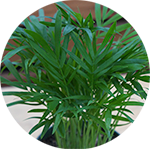
Parlor Palm/Neanthe Bella,
Chamaedorea elegans
Chamaedorea elegans
Light
Medium and high. Parlor palms are best with bright, indirect light and tolerate direct, cool light such as sun through the window in early morning or late evening.
Water
Medium. Tropical palms use water efficiently and don’t like to get too dry, or tips will burn. Keeping them too wet however, results in discolored fronds.
Care
High humidity for a bushier plant. Palms regulate their systems according to the humidity, they will drop fronds if the air is too dry, resulting in thinner-looking plant. Fertilize once a month for best foliage.
Traits
Air purifying. Safe for pets. Dry conditions can invite spider mites. If so, apply a houseplant systemic insecticide.
Medium and high. Parlor palms are best with bright, indirect light and tolerate direct, cool light such as sun through the window in early morning or late evening.
Water
Medium. Tropical palms use water efficiently and don’t like to get too dry, or tips will burn. Keeping them too wet however, results in discolored fronds.
Care
High humidity for a bushier plant. Palms regulate their systems according to the humidity, they will drop fronds if the air is too dry, resulting in thinner-looking plant. Fertilize once a month for best foliage.
Traits
Air purifying. Safe for pets. Dry conditions can invite spider mites. If so, apply a houseplant systemic insecticide.
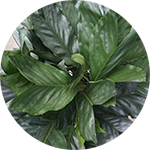
Bamboo Palm,
Chamaedorea seifrizii
Chamaedorea seifrizii
Light
High. Bamboo require bright indirect light and tolerate direct, cool light such as sun through the window in early morning or late evening.
Water
Medium. Tropical palms use water efficiently and don’t like to get too dry. Keeping them too wet however, results in fronds looking burned and the loss of foliage.
Care
High humidity. Palms regulate their systems according to the humidity; they will drop fronds if the air is too dry to keep all the foliage. Keep Bamboo palms out of drafts in a warmer location. Move away from cold windows in winter.
Traits
Air purifying. Safe for pets. Some people remove lower foliage to expose the bamboo look of the stems. One other variety is Chamaedorea falcifera with a wider, slightly greyish leaf.
High. Bamboo require bright indirect light and tolerate direct, cool light such as sun through the window in early morning or late evening.
Water
Medium. Tropical palms use water efficiently and don’t like to get too dry. Keeping them too wet however, results in fronds looking burned and the loss of foliage.
Care
High humidity. Palms regulate their systems according to the humidity; they will drop fronds if the air is too dry to keep all the foliage. Keep Bamboo palms out of drafts in a warmer location. Move away from cold windows in winter.
Traits
Air purifying. Safe for pets. Some people remove lower foliage to expose the bamboo look of the stems. One other variety is Chamaedorea falcifera with a wider, slightly greyish leaf.
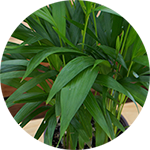
Areca Palm, Dypsis lutescens
Light
Medium and high. Areca are best with bright, indirect light and tolerate direct cool light, such as sun through the window in early morning or late evening.
Water
Medium and high. Areca are best with bright, indirect light and tolerate direct cool light, such as sun through the window in early morning or late evening.
Care
High humidity for a bushier plant. Palms regulate their systems according to the humidity. They’ll drop fronds if the air is too dry. Fertilize once a month for best foliage.
Traits
Air purifying. Safe for pets. Dry conditions can invite spider mites. If so, apply a houseplant systemic insecticide.
Medium and high. Areca are best with bright, indirect light and tolerate direct cool light, such as sun through the window in early morning or late evening.
Water
Medium and high. Areca are best with bright, indirect light and tolerate direct cool light, such as sun through the window in early morning or late evening.
Care
High humidity for a bushier plant. Palms regulate their systems according to the humidity. They’ll drop fronds if the air is too dry. Fertilize once a month for best foliage.
Traits
Air purifying. Safe for pets. Dry conditions can invite spider mites. If so, apply a houseplant systemic insecticide.
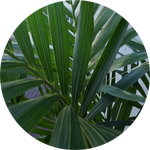
Kentia Palm, Howea forsteriana
Light
Medium and high. These palms are happiest with bright, indirect light and tolerate direct, cool light, such as sun through the window in early morning or late evening.
Water
Medium. Tropical palms use water efficiently and don’t like to get too dry. Keeping them too wet however, results in fronds that look burned.
Care
High humidity. Palms regulate their systems according to the humidity; they drop fronds if the air is too dry, resulting in foliage dropping.
Traits
Palms are safe for pets.
Medium and high. These palms are happiest with bright, indirect light and tolerate direct, cool light, such as sun through the window in early morning or late evening.
Water
Medium. Tropical palms use water efficiently and don’t like to get too dry. Keeping them too wet however, results in fronds that look burned.
Care
High humidity. Palms regulate their systems according to the humidity; they drop fronds if the air is too dry, resulting in foliage dropping.
Traits
Palms are safe for pets.
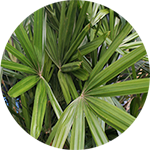
Lady Palm, Rhapis excelsa
Light
Low, medium and high. Lady Palm tolerates moderate to low light.
Water
High. This palm requires soil to be consistently moist. They are allowed to sit in very shallow water when the air is dry and warm.
Care
High humidity keeps this plant bushier and moist. Use Potting Soil when re-potting.
Traits
Easy to keep happy. Naturally slow growth. Rhaphis multifida species is similar, but with longer, narrow leaflets.
Low, medium and high. Lady Palm tolerates moderate to low light.
Water
High. This palm requires soil to be consistently moist. They are allowed to sit in very shallow water when the air is dry and warm.
Care
High humidity keeps this plant bushier and moist. Use Potting Soil when re-potting.
Traits
Easy to keep happy. Naturally slow growth. Rhaphis multifida species is similar, but with longer, narrow leaflets.
Tillandsia
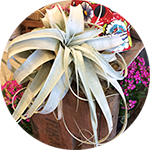
Air Plants, Tillandsia species
Light
Medium and high. Tillandsia grow in trees and on rocks in humid, tropical and sub-tropical areas around the world. They rely on leaf cover to protect from strong, direct light.
Water
High. In their native habitat, these plants take all their water and nutrients out of the air. Getting them completely wet with either a squirt bottle or submerging them once or twice a week usually keeps them happy. In drier conditions watering more may be necessary. Tillandsia rot if they are left submerged for long periods or set on a wet surface.
Care
High humidity. Use a very mild solution of fertilizer in water once a month.
Traits
These plants are epiphytes, a term for groups of plants that do not grow in soil. Keep away from drafts and windows; too warm and dry in summer, too cold in winter. Avoid submerging the flowers when in bloom. Have fun with these plants, they can be attached to any surface with a craft glue.
Medium and high. Tillandsia grow in trees and on rocks in humid, tropical and sub-tropical areas around the world. They rely on leaf cover to protect from strong, direct light.
Water
High. In their native habitat, these plants take all their water and nutrients out of the air. Getting them completely wet with either a squirt bottle or submerging them once or twice a week usually keeps them happy. In drier conditions watering more may be necessary. Tillandsia rot if they are left submerged for long periods or set on a wet surface.
Care
High humidity. Use a very mild solution of fertilizer in water once a month.
Traits
These plants are epiphytes, a term for groups of plants that do not grow in soil. Keep away from drafts and windows; too warm and dry in summer, too cold in winter. Avoid submerging the flowers when in bloom. Have fun with these plants, they can be attached to any surface with a craft glue.

